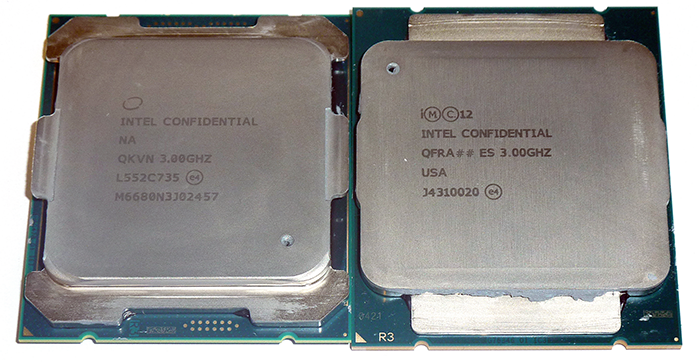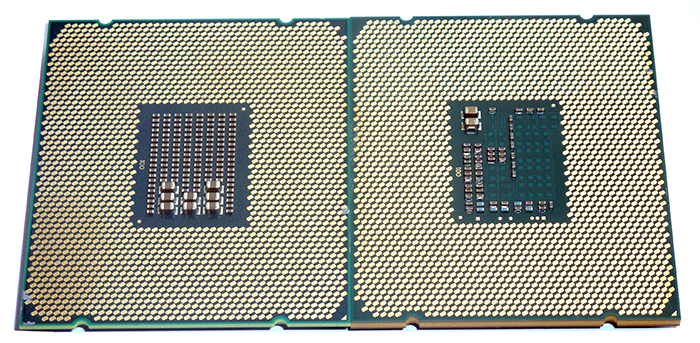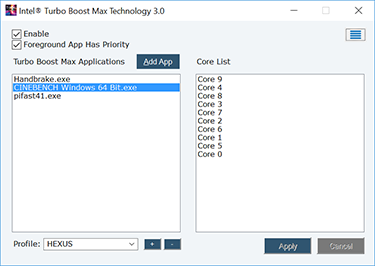Introduction
Intel CPU launches are something of an anachronism. The desktop and laptop CPUs arrive with the latest architecture while the server and workstation markets often receive older microarchitectures at a later date. We know this because sixth-generation Skylake made its retail bow on August 2015 for the desktop while previous-generation Broadwell, for the performance Xeon market, arrived at the back end of March 2016. Sure, Intel launched a smattering of other server chips in the interim time, but the anachronism assertion largely holds true.
And that time differential is key to explaining why the high-end performance processors often lag behind their mainstream counterparts by a number of months. These are the big chips, packing in lots of lots of cores for supreme CPU performance, and can be thought of as Xeons by a different name.
As of yesterday, the king of the Intel consumer CPUs was the Haswell-based, eight-core Core i7-5960X. Its wholesome performance is being put in the shade by a new champ, entering the ring today supported by a trio of other chips based on the extant Broadwell architecture.
That champ is the Core i7-6950X, previously known as Broadwell-E, and the first consumer processor to feature 10 cores and, via hyperthreading, 20 threads. Allied to a 3.0GHz base clock and 3.5GHz maximum frequency, the chip also features a new iteration of Turbo Boost Max 3.0 technology.
Let's contextualise the Core i7-6950X, and its three chums - 6900K, 6850K, 6800K - against other performance processors from the current Intel stable.
Desktop |
|||||||||||
|---|---|---|---|---|---|---|---|---|---|---|---|
Model |
Cores / Threads |
CPU Clock (GHz) |
Turbo Boost (GHz) |
Process |
Die Size |
Cache |
CPU PCIe lanes |
DDR Support (MHz) |
TDP |
Launch Price (US 1ku) |
|
| Broadwell-E Core Processor Family (5th Generation, LGA2011 v3) | |||||||||||
| Core i7-6950X | 10 / 20 |
3.0 |
3.5 |
22nm |
TBC |
25MB |
40 |
Quad 2,400 (DDR4) |
140W |
$1,569 |
|
| Core i7-6900K | 8 / 16 |
3.2 |
3.7 |
22nm |
TBC |
20MB |
40 |
Quad 2,400 (DDR4) |
140W |
$999 |
|
| Core i7-6850K | 6 / 12 |
3.6 |
3.8 |
22nm |
TBC |
15MB |
40 |
Quad 2,400 (DDR4) |
140W |
$587 |
|
| Core i7-6800K | 6 / 12 |
3.4 |
3.6 |
22nm |
TBC |
15MB |
28 |
Quad 2,400 (DDR4) |
140W |
$412 |
|
| Haswell-E Core Processor Family (4th Generation, LGA2011 v3) | |||||||||||
| Core i7-5960X | 8 / 16 |
3.0 |
3.5 |
22nm |
355mm² |
20MB |
40 |
Quad 2,133 (DDR4) |
140W |
$999 |
|
| Core i7-5930K | 6 / 12 |
3.5 |
3.7 |
22nm |
355mm² |
15MB |
40 |
Quad 2,133 (DDR4) |
140W |
$583 |
|
| Core i7-5820K | 6 / 12 |
3.3 |
3.6 |
22nm |
355mm² |
15MB |
28 |
Quad 2,133 (DDR4) |
140W |
$389 |
|
| Ivy Bridge Core Processor (3rd Generation, LGA2011) | |||||||||||
| Core i7-4960X | 6 / 12 |
3.6 |
4.0 |
22nm |
257mm² |
15MB |
40 |
Quad 1,866 (DDR3) |
130W |
$999 |
|
| Sandy Bridge Core Processor Family (2nd Generation, LGA2011) | |||||||||||
| Core i7-3970X | 6 / 12 |
3.5 |
4.0 |
32nm |
434mm² |
15MB |
40 |
Quad 1,600 (DDR3) |
150W |
$999 |
|
Core i7-6950X
The Broadwell architecture will add a few per cent extra performance over the Haswell-E chips due to an improvement in the instructions-per-cycle throughput. What's applicable to the Xeon E5 v4 parts, based on the same Core architecture, is also relevant in the consumer space, so expect in the order of an extra five per cent uplift across a broad range of benchmarks. A little extra is further added by increasing the supported memory speed from 2,133MHz to 2,400MHz and ability to run AVX and non-AVX workloads at higher overall speeds.
Such comparisons conveniently ignore the salient fact that Intel shoehorns in 25 per cent more cores - 10 vs. eight - on the top-of-the-range chip. Given that the 6950X and 5960X share the same base and boost speeds, we can infer that in heavily-threaded tests, where all cores can be pushed, overall performance should be 25-35 per cent faster than the incumbent performance processor.
More cores need to be sated with more cache. Core i7-6950X, therefore, keeps the 2.5MB-per-core ratio intact and balloons the L3 cache to 25MB. The upshot, one would assume, is a slightly bigger die than the 5960X, which is fabbed on the same process, yet, from a thermal perspective, Intel manages to fit more cores and more cache into the same 140W TDP envelope.
Intel Core i7-6950X on the left, Core i7-5960X on the right
Intel has historically sold its best consumer processors at $999, consistent between the Sandy Bridge and Haswell eras. That changes today. Core i7-6950X comes in at a whopping $1,569, which is testament to a severe lack of competition in this area and the understanding that we're witnessing never-before-seen performance in the high-end desktop space. We leave it up to you to evaluate whether such an outlay makes sense, though do be aware that Xeons, using the same architecture infrastructure, albeit with a few extra features, can cost significantly more.
Intel Core i7-6950X on the left, Core i7-5960X on the right
The new chips share the LGA2011 v3 form factor as their immediate predecessors, and this means that all X99 motherboards should support the Broadwell-E chips through a simple BIOS update. Intel's partners are attempting to make the most of this premium launch by revisiting the X99 chipset and launching a number of 'new' boards. You can see our coverage of the Asus X99 Strix Gaming and MSI today, too.
The Supporting Cast
A trio of other Broadwell-E chips represent a near-identical copy of the three Haswell-E chips. The eight-core Core i7-6900K is an obvious substitute for the 5960X while the 6850K and 6800K effectively replace the vital specs of the 5930K and 5820K, respectively, albeit with one small exception. For reasons that still remain a mystery, Intel decided to hamstring the Core i7-5820K, for gamers at least, by limiting the number of PCIe lanes emanating from the processor from the usual roster of 40 down to 28. The same mistake is also made for the Core i7-6800K, too.
Turbo Boost Max 3.0
A new feature on the quartet of LGA2011 v3 processors is Turbo Boost Max 3.0 (TBM3) technology. Intel has been building processors that opportunistically boost their base frequency based on the number of cores available. For example, the usurped Core i7-5960X has a base clock of 3.0GHz and, during light loads and if the motherboard BIOS is configured correctly, runs up to 3.5GHz. You can, of course, ratchet this speed up by manual overclocking.
TBM3 takes a slightly different tack, considering the number of cores and threads available on processors of this ilk. The sensible premise of any efficient technology is to get done work done as quickly as possible. When fully loaded on all 10 cores and 20 threads there is little scope for extra frequency - Intel says the chip boosts to 3.3GHz in such scenarios - but imagine the amount of scaling headroom if light loads are being processed.
TBM3, according to Intel, improves lightly-threaded performance by pushing such applications to the fastest available cores on the die, calculated by a driver interrogating the system. But such a process is not automatic. As you see from the pictures above, applications need to be added to the TBM3 program, which identifies the fastest cores in in column order, and then places the workloads on them for the most efficient processing. You'll notice that the cores are listed in non-sequential order, so without TBM3 present the system would pick any available core irrespective of how well it purportedly scales.
The driver polls the system at 100ms intervals in order to calculate whether load is being imposed. That level of load can be adjusted through the advanced sections, though Intel reckons it should be left high in order for the feature to work correctly. Further options, such as affinity, enable the system to either place work on all cores in the list or simply on higher-performing ones.
We always benchmark CPUs by rigorously sticking the the Turbo Boost scaling mandated by Intel, leading to consistent results. Activating TBM3 did little to enhance performance in our suite; we found a < five per cent performance improvement on HEXUS PiFast and a statistically insignificant jump when running either wPrime or the demanding HandBrake test.
Point is pushing work on to the fastest cores makes implicit sense, but can some cores run appreciably faster than others in a single-threaded instance? Perhaps what would be more of use in future iterations of TBM3 is some form of minor CPU voltage overclocking, enabling a few cores to increase their speed, momentarily, to 4GHz. As it stands, we're intrigued by TBM3 but not wholly taken with it. It will be interesting to see how TBM3 evolves on mobile and mainstream desktop processors though.













